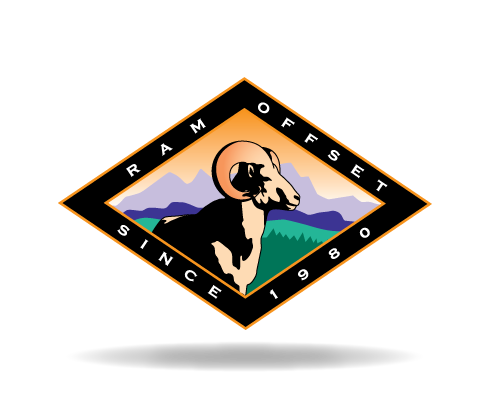Ram Offset appreciates each one of our clients. Every one of our clients has their own way of submitting files to us for printing.
From the DIY designer to the professional, we see all types of files provided to us, created in a variety of software. It goes without saying that each client has their own level of design experience. Even the most professional designer will occasionally slip up and provide a file that is not 100% perfect. Read on to see our list of the TOP 10 Topics we run into with client-supplied files.
- NO BLEED
bleed
/blēd/
an instance of printing an illustration, design, or text to the edge of the page.
“it allows printing of a tabloid page with full bleed”
In printing, bleed is when you have a little extra image extending past the trim area. When your job is trimmed on the guillotine cutter, the bleed is trimmed off, along with the crop marks, color bars and other items we use to ensure a quality piece is printed.
Minimum bleed required is .125” bleed on all four sides. Depending on the software you use to create your file, you may need to create a file that is larger than the final size to allocate for bleed.

- INCORRECT SIZE
When your job is estimated for printing, it is engineered to repeat your artwork on a large sheet, until the sheet is full. The number of sheets is then calculated and ordered.
If the artwork that is provided that does not match the original specifications used to estimate the job, the entire project needs to be re-engineered. This can result in restocking fees and a delay in your job being printed.

- LOW RESOLUTION
With so many images on the internet that look perfect on screen, it is often tempting to utilize one in your print project. These images are reduced in quality for faster screen loading and are not suitable for printing.
Our policy is to notify you when an image is lower than 150dpi.
- MISSING ELEMENTS
A designed piece is made up of multiple elements. When we are provided native files, we also need to have all the elements that you used to design the piece on your work station. These elements are the photos, logos, and fonts. Some software has ‘packaging’ or ‘collecting’ options which will gather all the elements for you.
- FONTS NOT EMBEDDED
The most common file type we receive is a pdf. Occasionally, we will receive a pdf that does not have the fonts embedded in the file. When a pdf without fonts is provided, the file will not process through our prepress software.
A simple check of your file properties while viewing the pdf will show if your fonts are embedded or not.
- NO FILES SUBMITTED AT ALL
At the time an estimate is approved, the gears start turning to produce your printed piece. A job ticket is made; stock and all necessary materials are ordered and machine time is scheduled. If your files are delayed in arriving, or proofs are delayed in getting approved, the entire schedule is altered. If you are unsure as to when your files will be provided, please convey that information to your CSR.
- FILE TYPE NOT SUPPORTED
Everyone has a computer, but not everyone has professional design software. Every software has its strengths and weaknesses, with one of the main weaknesses being that the “cheaper” software doesn’t look the same when opened on a different computer.
Ideally, a CMYK press ready pdf, with fonts embedded alleviates this problem.
- BLACK TEXT NOT BLACK TEXT
We often receive documents with black text created with colors other than black. Text copied and pasted from Microsoft Word is RGB black and Registration Black is often selected in design software.
Verify your black text is only black text by checking your Print Production / Print Preview.

- RGB COLOR SPACE
Although it is not the end of the world to submit RGB files in your document, it is helpful if you can convert your images to CMYK prior to submittal. There is often a color shift when colors are converted to CMYK, and it is ideal for a client to see that happen on their workstation than on a hard copy proof or the final printed product.
- PAGE COUNT
Similar to “2. Incorrect Size” mentioned above, a job is engineered with a page count, utilizing the entire press sheet and performing the most productive folds. When additional or fewer pages are provided, the layout of the press sheets needs to be recalculated. This may require the purchase of more paper; additional press and bindery time, which may accrue additional charges and delay in your estimated due date.

If you have any questions, contact your CSR or salesperson. We are always eager to help educate our clients!

